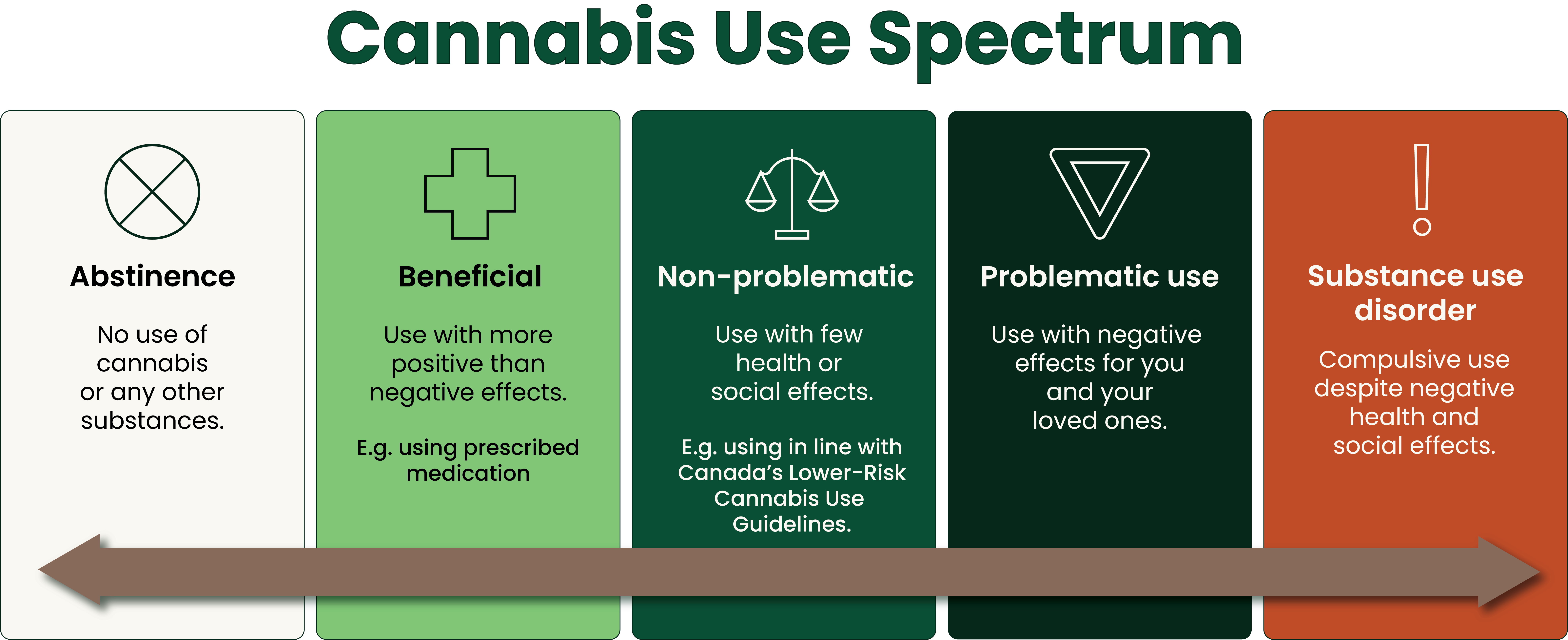
What is moderation?
Moderation can mean a lot of different things, especially when it comes to cannabis use.
How often you reach for your product of choice, the potency of the products you’re using and any extra health risks that might come with how you use cannabis are all part of the moderation conversation.
We’ve put together some tips below to help you find that “just right” balance between enjoyment, responsibility, and your health.
When it comes to cannabis, moderation is your best bud.
Moderation is all about using just enough to enjoy the effects of cannabis while keeping the amount, potency, frequency and way you use cannabis as low-risk as possible.
And because cannabis affects everyone differently, moderation will also look a little bit different for everyone. While listening to your body is particularly important for finding an approach to moderation that works for you, CannabisSense is also here to give you research-backed recommendations for moderating your use.
Studies show that without moderation, the risk for disordered use increases.
So, when should you use moderation?
The short answer is always. Because cannabis is an enjoyable and potentially risky activity moderation is essential. The (slightly) longer answer is a bit more nuanced, and based on your personal risk and responsibilities including:
- being new to cannabis,
- health issues
- concerns about the long-term effects on your brain and memory, or
- demands on your time like work, school or driving.
All of these are factors that call for really tapping into moderation.
As for just how much moderation you should be tapping into, that’s a personal choice and dependent on your health, level of risk and type of cannabis use. Studies show that without moderation, the risk for disordered use increases.

FYHigh—our tips below are a great way to make sure that moderation is your go-to for low-risk cannabis use.
Amount
Tip: Start low and go slow by using smaller amounts of products.
If you're new to cannabis, it’s recommended to start by using or ingesting a small amount, 2.5mg for edibles and beverages and less than 10% THC for dried flowers products. Then, it’s best to wait as it can take between 30 minutes to two hours to start feeling the effects of cannabis and even longer to feel the full effects. Make sure you know how a small amount affects you before going for seconds.
Frequency
Tip: Stick to occasional use, one day a week, just on weekends, or less.
Pay attention to when you’re using cannabis. Keeping it casual and social is a good rule of thumb. By the numbers, this means only using cannabis three to four times a month.
If it’s starting to feel like cannabis is part of your daily routine, or if you feel like you need cannabis to get through the day, you could be stepping into high-risk territory. On top of elevating your risks, over time, frequent use can lead to a buildup of THC in your system, increasing the chances of needing more to get the same effects, dependence, and other challenges.
Find more on Canada’s Cannabis Lower-Risk Use Guidelines here.
Potency
Tip: Use products with low THC content and products that have a high CBD content.
The higher the THC the higher the risk. The potency of the type of product you’re using is the key factor for moderation. Products higher in THC are often associated with greater health risks and nasty side effects like nausea, vomiting, dizziness and anxiety. Any product with THC content over 10% is considered high potency and makes your cannabis use riskier, especially if you’re a new user.
PS: Remember those nasty side effects? Well, vaping products almost always have higher THC content, so we recommend new users stay away from vaping all together and that experienced users pay extra attention to how much they are vaping.
Ways you use
Tip: Avoid smoking and choose safer methods.
Where there’s smoke (or vapour), there’s higher health risks. When you’re reaching for a joint, bong or vape, you’re also adding the potential for lung health and breathing issues to your cannabis routine. Smoking cannabis comes with the presence of carcinogens, and vaping has been associated with severe breathing problems that can require hospitalization.
If you choose to vape, dab, or smoke cannabis, do your best to make it an occasional occurrence. As an alternative, we’d suggest looking into cannabis oils capsules, sprays or edibles. While these products are good for lower-risk use, that doesn't mean they are no risk. Edibles especially can be tricky to navigate since it can take up to four hours for you to feel the effects.
You can learn all about edibles and other methods of consumption here.
Age of first use
Tip: Pass on grass until you’re 25.
Delaying your first use of cannabis till age 25 (or later) might feel like the equivalent to planning for retirement, but in the end, it pays off big for your brain. Starting to use cannabis regularly before your brain has fully developed, specifically the prefrontal cortex—the front part of your brain that controls your judgment and personal awareness—increases the risk of potential cognitive and mental health issues later in life and puts you at a greater risk for developing chronic use. Remember, the younger you begin using cannabis and the more often you use, the higher your risk. More information on how cannabis affects the development of your brain can be found here.
Get goal-oriented
Tip: Decide in advance what your cannabis goals are and stick to them.
Think of this like setting cannabis goals that impact two different kinds of green. This could mean cutting back how much money you spend on cannabis, limiting how much product you’re using, or reducing how often you’re using. It’s important to make these feel like achievable, realistic goals which means that they are completely tailored to you, your use and your moderation.
In real life, that can look like:
- Not smoking before 7 p.m.
- Using products that have less than 10% THC content.
- Only using edibles on weekends after dinner.
- Spending $20 less on cannabis in a month.
What happens if I struggle with moderation?
Struggling with moderation goes beyond the occasional indulgence and can causes physical, psychological, economic, or social problems.
Substance use falls on a spectrum, ranging from abstinence, to beneficial, to non-problematic, to problematic use and, finally, substance use disorder.

Cannabis use isn't black and white—there are many shades of green (pun intended) when it comes to substance use.
If you think your cannabis use might be a problem or are concerned about a friend, talk to your medical provider or find support here.